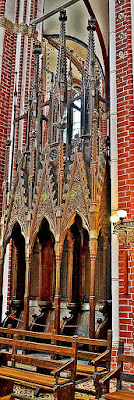To begin with, let me say that I have never been to this place; in fact, I have never been anywhere in the former DDR, so my only knowledge of this church is through the internet. Sometimes Wikipedia is a nuisance, but sometimes it is quite a boon, as it was in the case of the article on the Bad Doberaner Münster. The main interest for me in this article is all of the pictures of furnishings that accompany it.
 |
Detail of the Chalice cupboard from "ca 1310" according to Wikipedia.
It was never repainted but still shows some of its original colour and gilding,
proving the accuracy of other objects which have been restored.
(all photos in this post were taken from "Wikimedia") |
This church is remarkable for many reasons, such as the fact that its sell was completed in a span of only 15 years, it survived, most of the destruction brought on by the many wars during its history, and the various renovations that subsequent styles dictated, and by the fact that it retains a wealth of furniture which still survives from the time of its original construction at the turn of the 14th century.
 |
The restored High Altar of the church. Though restored, it is still missing all
of the three dimensional figures which once filled the central arcades; looted
by someone during the Napoleonic wars or the 30 Years War. |
It is for that reason that I point it out in this blog. Most people reading this English language blog probably would not otherwise be exposed to a church in Eastern Germany, but I feel that it should be a must visit place for anyone interested in later medieval history, especially pertaining to furniture. It is even worthy of being a 'pilgrimage destination' for the serious medieval woodworker.
 |
Another view showing the chalice cupboard opened. Part of a
"sacrament tower" from the mid 14th century stands at
the right of the picture. |
The interior of this cabinet has not been repainted, and shows the original work of ca 1310. It is worth noting how the painting is done right over all of the iron hardware. Most surviving chests from this period have long since lost their paint, but were, in all probability, painted in like manner; only the subject and design varying. This would give a very different look to the furniture than that which most people hold in their minds of dusty grey wood and rusty iron objects; things which no respecting person in the Middle Ages would have ever furnished their house with.
 |
| Two 14th century altars which have suffered greatly the ravishes of time |
Whilst this church is in remarkable condition, and maintains an extraordinary amount of its original furnishings, it too, suffered the toll of multiple wars and the sad events of the "Reformation" Many items were destroyed, looted, or otherwise damaged beyond recognition. Here is an altar which has lost every trace of its painting and gilding, and another which has lost nearly all, but has suffered the further indignity of being sawn up, most likely by some greedy art dealer or thief.
 |
A set of benches and a
reproduction baldaquin |
Not everything looted or sold off from this church has been lost to us, as the original baldaquin (canopy) to this set of seats made its way about an hour south, to a Neo-Gothic Catholic church built in 1803 in the town of Ludwigslust. During the 19th century restoration of the Bad Doberan church a new baldaquin was replicated for this set of seats. Since the original is still extant, we can see that sometimes the 19th century restorers work was very faithful to the original, and perhaps the stigma that goes with their work is not always well deserved.
 |
Here is the original baldaquin, it has been repainted, and the figures which
would have originally habited the niches on the columns are missing, as is the
original gilding, but the carving is still in a good state and shows the accuracy
of the 19th century copy. |
Another cupboard which was probably on the opposite end of the now missing rood screen (made of brick), and paired with the above chalice cupboard was a sacrament cupboard of about the same date, or possibly from the earlier church. Its state of preservation is not quite as good as the chalice cupboard, but is still quite good.
 |
| Sacrament cupboard |
 |
Wooden remains from other cupboards or some other form of furnishings.
Perhaps these objects were original to the 13th century church which was
incorporated (and largely demolished) into the new church of 1296. |
Not only are there several cabinets (there are some small wall cabinets as well) still at the church, there are also still intact, the choir stalls which were reused from the 13th century church, but with new canopies added. (there are also some early 14th century stalls)
 |
| Carving detail |
 |
| 13th century stalls with early 14th century canopies. |
All in all, I would say it is a small miracle to find so many things still preserved in their original place from this time period, and anyone thinking of visiting Germany should definitely consider having a look at this remarkable monument to history.












